Estimation of Lightning Activity of Squall Lines by Different Lightning Parameterization Schemes in the Weather Research and Forecasting Model
Abstract
:1. Introduction
| Reference | Parameters | Model |
|---|---|---|
| Price and Rind [37] | CTH, updraft | WRF |
| McCaul et al. [38] | upward fluxes of precipitating ice, vertically integrated amounts of ice | WRF |
| Li et al. [39] | masses of sinkable and non-sinkable ice | WRF |
| Barthe et al. [40] | precipitation ice mass, ice–water path, ice mass flux, updraft volume, w, CTH, updraft volume | WRF |
| Bright et al. [41] | combine LCL, middle-level CAPE and equilibrium layer temperature | WRF |
| Yair et al. [42] | LPI | WRF |
| Lynn et al. [8] | EP | WRF |
| Tost et al. [45] | updraft velocity, CTH, updraft volume flux, and surface convective precipitation | ECHAM5/MESSy |
| Romps et al. [46] Finney et al. [47] | CAPE × P flux of cloud–ice parameters | global climate model (GCM) UM-UKCA |
2. Materials and Methods
2.1. Data
2.1.1. Lightning Data
2.1.2. Radar Data
2.1.3. Metrological Data
2.1.4. WRF Model Configuration
2.2. Lightning Parameterization Schemes in the WRF Model
3. Results
3.1. The Study Case
3.2. The Establishment of Radar-Based Lightning Parameterization Schemes
3.3. The Comparative Verification of Dynamical and Microphysical Characteristics of the Squall Line
3.4. The Comparison by Different Lightning Parameterization Schemes
3.5. The Verification of Lightning Prediction in Different Squall Line Cases
4. Summary and Discussion
Author Contributions
Funding
Data Availability Statement
Acknowledgments
Conflicts of Interest
References
- Metzger, E.; Nuss, W.A. The relationship between total cloud lightning behavior and radar-derived thunderstorm structure. Weather Forecast. 2013, 28, 237–253. [Google Scholar] [CrossRef]
- Qie, X.; Yuan, S.; Chen, Z.; Wang, D.; Liu, D.; Sun, M.; Sun, Z.; Srivastava, A.; Zhang, H.; Lu, J.; et al. Understanding the dynamical-microphysical-electrical processes associated with severe thunderstorms over the Beijing metropolitan region. Sci. China Earth Sci. 2020, 64, 10–26. [Google Scholar] [CrossRef]
- Zheng, D.; Zhang, Y.J.; Meng, Q.; Chen, L.W.; Dan, J.R. Climatological Comparison of Small- and Large-Current Cloud-to-Ground Lightning Flashes over Southern China. J. Clim. 2016, 29, 2831–2848. [Google Scholar] [CrossRef]
- Harel, M.; Price, C. Thunderstorm Trends over Africa. J. Clim. 2020, 33, 2741–2755. [Google Scholar] [CrossRef]
- Schultz, C.J.; Carey, L.D.; Schultz, E.V.; Blakeslee, R.J. Kinematic and microphysical significance of lightning jumps versus nonjump increases in total flash rate. Weather Forecast. 2017, 32, 275–288. [Google Scholar] [CrossRef]
- Tian, Y.; Qie, X.; Sun, Y.; Wang, D.; Yuan, S.; Sun, Z.; Lu, G.; Yu, L.; Sun, H.; Li, L.; et al. Total lightning signatures of thunderstorms and lightning jumps in hailfall nowcasting in the Beijing area. Atmos. Res. 2019, 230, 104646. [Google Scholar] [CrossRef]
- Deierling, W.; Petersen, W.A.; Latham, J.; Ellis, S.; Christian, H.J. The relationship between lightning activity and ice fluxes in thunderstorms. J. Geophys. Res. 2008, 113, 1–20. [Google Scholar] [CrossRef]
- Lynn, B.H.; Yair, Y.; Shpund, J.; Levi, Y.; Qie, X.; Khain, A. Using factor separation to elucidate the respective contributions of desert dust and urban pollution to the 4 January 2020 Tel Aviv lightning and flash flood disaster. J. Geophys. Res. 2020, 125, e2020JD033520. [Google Scholar] [CrossRef]
- Stough, S.M.; Carey, L.D.; Schultz, C.J.; Cecil, D.J. Examining conditions supporting the development of anomalous charge structures in supercell thunderstorms in the Southeastern United States. J. Geophys. Res. 2021, 126, e2021JD034582. [Google Scholar] [CrossRef]
- Stolz, D.C.; Rutledge, S.A.; Pierce, J.R.; van den Heever, S.C. A global lightning parameterization based on statistical relationships among environmental factors, aerosols, and convective clouds in the TRMM climatology. J. Geophys. Res. 2017, 122, 7461–7492. [Google Scholar] [CrossRef]
- Fan, J.T.; Yuan, J.M.; Comstock, S.; Ghan, A.; Khain, L.R.; Leung, Z.; Li, V.J. Martins, and M. Ovchinnikov. Dominant role by vertical wind shear in regulating aerosol effects on deep convective clouds. J. Geophys. Res. 2009, 114, D22206. [Google Scholar] [CrossRef]
- Liu, D.; Sun, M.; Su, D.; Xu, W. A five-year climatological lightning characteristics of linear mesoscale convective systems over North China. Atmos. Res. 2021, 256, 105580. [Google Scholar] [CrossRef]
- Grant, L.D.; van den Heever, S.C. Microphysical and dynamical characteristics of low-precipitation and classic supercells. J. Atmos. Sci. 2014, 71, 2604–2624. [Google Scholar] [CrossRef]
- Fan, J.; Zhang, R.; Li, G.; Tao, W.K. Effects of aerosols and relative humidity on cumulus clouds. J. Geophys. Res. 2007, 112, D14204. [Google Scholar] [CrossRef]
- Li, J.; Wu, X.; Yang, J.; Jiang, R.; Yuan, T.; Lu, J.; Sun, M. Lightning activity and its association with surface thermodynamics over the Tibetan Plateau. Atmos. Res. 2020, 245, 105118. [Google Scholar] [CrossRef]
- Williams, E.R.; Mushtak, T.V.; Rosenfeld, D.; Goodman, S.; Boccippio, D. Thermodynamic conditions favorable to superlative thunderstorm updraft, mixed phase microphysics and lightning flash rate. Atmos. Res. 2005, 76, 288–306. [Google Scholar] [CrossRef]
- Petersen, W.A.; Christian, H.J.; Rutledge, S.A. TRMM observations of the global relationship between ice water content and lightning. Geophys. Res. Lett. 2005, 32, L14819. [Google Scholar] [CrossRef]
- Carey, L.D.; Schultz, E.V.; Schultz, C.J.; Deierling, W.; Petersen, W.A.; Bain, A.L.; Pickering, K.E. An Evaluation of Relationships between Radar-Inferred Kinematic and Microphysical Parameters and Lightning Flash Rates in Alabama Storms. Atmosphere 2019, 10, 796. [Google Scholar] [CrossRef]
- Lu, J.; Qie, X.; Xiao, X.; Jiang, R.; Mansell, E.R.; Fierro, A.O.; Liu, D.; Chen, Z.; Yuan, S.; Sun, M.; et al. Effects of convective mergers on evolution of microphysical and electrical activity in a severe squall line simulated by WRF coupled with explicit electrification scheme. J. Geophys. Res. 2022, 127, e2021JD036398. [Google Scholar] [CrossRef]
- Zipser, E.J.; Lutz, K.R. The Vertical Profile of Radar Reflectivity of Convective Cells: A Strong Indicator of Storm Intensity and Lightning Probability? Mon. Weather Rev. 1994, 122, 1751–1759. [Google Scholar] [CrossRef]
- Boussaton, M.P.; Soula, S.; Coquillat, S. Total lightning activity in thunderstorms over Paris. Atmos. Res. 2007, 84, 221–232. [Google Scholar] [CrossRef]
- Wang, Y.; Yang, Y.; Wang, C. Improving forecasting of strong convection by assimilating cloud-to-ground lightning data using the physical initialization method. Atmos. Res. 2014, 150, 31–41. [Google Scholar] [CrossRef]
- Chen, Z.; Qie, X.; Yair, Y.; Liu, D.; Xiao, X.; Wang, D.; Yuan, S. Electrical evolution of a rapidly developing MCS during its vigorous vertical growth phase. Atmos. Res. 2020, 246, 105201. [Google Scholar] [CrossRef]
- Lu, J.; Qie, X.; Jiang, R.; Xiao, X.; Liu, D.; Li, J.; Yuan, S.; Chen, Z.; Wang, D.; Tian, Y.; et al. Lightning activity during convective cell mergers in a squall line and corresponding dynamical and thermodynamical characteristics. Atmos. Res. 2021, 256, 105555. [Google Scholar] [CrossRef]
- Price, C.; Rind, D.A. Simple Lightning Parameterization for Calculating Global Lightning Distributions. J. Geophys. Res. 1992, 97, 9919–9933. [Google Scholar] [CrossRef]
- Wiens, K.C.; Rutledge, S.A.; Tessendorf, S.A. The 20 June 2000 supercell observed during STEPS. Part II: Lightning and charge structure. J. Atmos. Sci. 2005, 62, 4151–4177. [Google Scholar] [CrossRef]
- Basarab, B.M.; Rutledge, S.A.; Fuchs, B.R. An improved lightning flash rate parameterization developed from Colorado DC3 thunderstorm data for use in cloud-resolving chemical transport models. J. Geophys. Res. 2015, 120, 9481–9499. [Google Scholar] [CrossRef]
- Mansell, E.R.; Ziegler, C.L.; Bruning, E.C. Simulated Electrification of a Small Thunderstorm with Two-Moment Bulk Microphysics. J. Atmos. Sci. 2010, 67, 171–194. [Google Scholar] [CrossRef]
- Mansell, E.R.; MacGorman, D.R.; Ziegler, C.L.; Straka, J.M. Charge structure and lightning sensitivity in a simulated multicell thunderstorm. J. Geophys. Res. 2005, 110, D12101. [Google Scholar] [CrossRef]
- Tan, Y.; Tao, S.; Zhu, B. Fine-resolution simulation of the channel structures and propagation features of intracloud lightning. Geophys. Res. Lett. 2006, 33, L09809. [Google Scholar] [CrossRef]
- Fierro, A.; Mansell, E.R.; MacGorman, D.R.; Ziegler, C.L. The Implementation of an Explicit Charging and Discharge Lightning Scheme within the WRF-ARW Model: Benchmark Simulations of a Continental Squall Line, a Tropical Cyclone, and a Winter Storm. Mon. Weather Rev. 2013, 141, 2390–2415. [Google Scholar] [CrossRef]
- Zhao, P.; Yin, Y.; Xiao, H. The effects of aerosol on development of thunderstorm electrification: A numerical study. Atmos. Res. 2015, 153, 376–391. [Google Scholar] [CrossRef]
- DiGangi, E.A.; Ziegler, C.L.; MacGorman, D.R. Lightning and secondary convection in the anvil of the May 29, 2012 Oklahoma supercell storm observed by DC3. J. Geophys. Res. 2021, 126, e2020JD033114. [Google Scholar] [CrossRef]
- Sun, M.; Liu, D.; Qie, X.; Mansell, E.R.; Yair, Y.; Fierro, A.O. Aerosol effects on electrification and lightning discharges in a multicell thunderstorm simulated by the WRF-ELEC model. Atmos. Chem. Phys. 2021, 21, 14141–14158. [Google Scholar] [CrossRef]
- Dementyeva, S.; Shatalina, M.; Popykina, A.; Sarafanov, F.; Kulikov, M.; Mareev, E. Trends and Features of Thunderstorms and Lightning Activity in the Upper Volga Region. Atmosphere 2023, 14, 674. [Google Scholar] [CrossRef]
- Fierro, A.O.; Mansell, E.R. Relationships between Electrification and Storm-Scale Properties Based on Idealized Simulations of an Intensifying Hurricane-Like Vortex. J. Atmos. Sci. 2018, 75, 657–674. [Google Scholar] [CrossRef]
- Price, C.; Rind, D. Possible implications of global climate change on global lightning distributions and frequencies. Geophys. Res. Lett. 1994, 99, 10823–10831. [Google Scholar] [CrossRef]
- McCaul, E.W.; Goodman, S.J.; LaCasse, K.M.; Cecil, D.J. Forecasting Lightning Threat Using Cloud-Resolving Model Simulations. Weather Forecast. 2009, 24, 709–729. [Google Scholar] [CrossRef]
- Li, W.; Qie, X.; Fu, S. Simulation of quasi-linear mesoscale convective systems in northern China: Lightning activities and storm structure. Adv. Atmos. Sci. 2016, 33, 85–100. [Google Scholar] [CrossRef]
- Barthe, C.; Deierling, W.; Barth, M.C. Estimation of total lightning from various storm parameters: A cloud-resolving model study. J. Geophys. Res. 2010, 115, 1–17. [Google Scholar] [CrossRef]
- Bright, D.R.; Wandisin, M.S.; Jewell, R.E. A physically based parameter for lightning prediction and its calibration in ensemble forecasts. In Proceedings of the Conference on Meteorological Applications of Lightning Data, San Diego, CA, USA, 9–13 January 2005. [Google Scholar]
- Yair, Y.; Lynn, B.; Price, C. Predicting the potential for lightning activity in Mediterranean storms based on the Weather Research and Forecasting (WRF) model dynamic and microphysical fields. J. Geophys. Res. 2010, 115, 1–13. [Google Scholar] [CrossRef]
- Brisson, E.; Blahak, U.; Lucas-Picher, P.; Purr, C.; Ahrens, B. Contrasting lightning projection using the lightning potential index adapted in a convection-permitting regional climate model. Clim. Dyn. 2021, 57, 2037–2051. [Google Scholar] [CrossRef]
- Mortelmans, J.; Bechtold, M.; Brisson, E.; Lynn, B.; Kumar, S.; Lannoy, G.D. Lightning over central Canada: Skill assessment for various land-atmosphere model configurations and lightning indices over a boreal study area. J. Geophys. Res. 2022, 128, e2022JD037236. [Google Scholar] [CrossRef]
- Tost, H.; Joeckel, P.J.; Lelieveld, J. Lightning and convection parameterizations—Uncertainties in global modelling. Atmos. Chem. Phys. 2007, 7, 4553–4568. [Google Scholar] [CrossRef]
- Romps, D.M.; Seeley, J.T.; Vollaro, D.; Molinari, J. Projected Increase in lightning strikes in the United States due to global warming. Science 2014, 346, 851–854. [Google Scholar] [CrossRef]
- Finney, D.L.; Doherty, R.M.; Wild, O.; Stevenson, D.S.; MacKenzie, I.A.; Blyth, A.M. A projected decrease in lightning under climate change. Nat. Clim. Chang. 2018, 8, 210–213. [Google Scholar] [CrossRef]
- Wang, Y.; Qie, X.; Wang, D.; Liu, M. Beijing Lightning Network (BLNET): A research and operational system for comprehensive lightning detection. Atmos. Res. 2016, 171, 121–132. [Google Scholar]
- Chan, Y.T.; Ho, K.C. A simple and efficient estimator for hyperbolic location. IEEE Trans Signal Process 1994, 42, 1905–1915. [Google Scholar] [CrossRef]
- Levenberg, K. A Method for the Solution of Certain Problems in Least Squares. Q. Appl. Math. 1944, 2, 164–168. [Google Scholar] [CrossRef]
- Marquardt, D.W. An algorithm for least-squares estimation of nonlinear parameters. J. Soc. Ind. Appl. Math. 1963, 11, 431–441. [Google Scholar] [CrossRef]
- Srivastava, A.; Tian, Y.; Qie, X. Performance assessment of Beijing Lightning Network (BLNET) and comparison with other lightning location networks across Beijing. Atmos. Res. 2017, 197, 76–83. [Google Scholar] [CrossRef]
- Cummins, K.L.; Murphy, M.J.; Bardo, E.A.; Hiscox, W.L.; Pyle, R.B.; Pifer, A.E. A combined TOA/MDF technology upgrade of the U.S. national lightning detection network. J. Geophys. Res. 1998, 103, 9035–9044. [Google Scholar] [CrossRef]
- Michalon, N.; Nassif, A.; Saouri, T.; Royer, J.F.; Pontikis, C.A. Contribution to the climatological study of lightning. Geophys. Res. Lett. 1999, 26, 3097–3100. [Google Scholar] [CrossRef]
- Xiao, X.; Sun, J.; Qie, X.; Ying, Z.; Ji, L.; Chen, M.; Zhang, L. Lightning Data Assimilation Scheme in a 4DVAR System and its Impact on Very-Short-Term Convective Forecasting. Mon. Weather Rev. 2021, 149, 353–373. [Google Scholar] [CrossRef]
- Carey, L.D.; Murphy, M.J.; McCormick, T.L.; Nicholas, W.S. Lightning location relative to storm structure in a leading-line, trailing-stratiform mesoscale convective system. J. Geophys. Res. 2005, 110, D03105. [Google Scholar] [CrossRef]
- Chen, Z.; Qie, X.; Liu, D.; Xiong, Y. Lightning data assimilation with comprehensively nudging water contents at cloud-resolving scale using WRF model. Atmos. Res. 2019, 221, 72–87. [Google Scholar] [CrossRef]
- Takahashi, T. Riming Electrification as a Charge Generation Mechanism in Thunderstorms. J. Atmos. Sci. 1978, 35, 1536–1548. [Google Scholar] [CrossRef]
- Saunders, C.P.R.; Keith, W.D.; Mitzeva, R.P. The effect of liquid water on thunderstorm charging. J. Geophys. Res. 1991, 96, 11007–11017. [Google Scholar] [CrossRef]

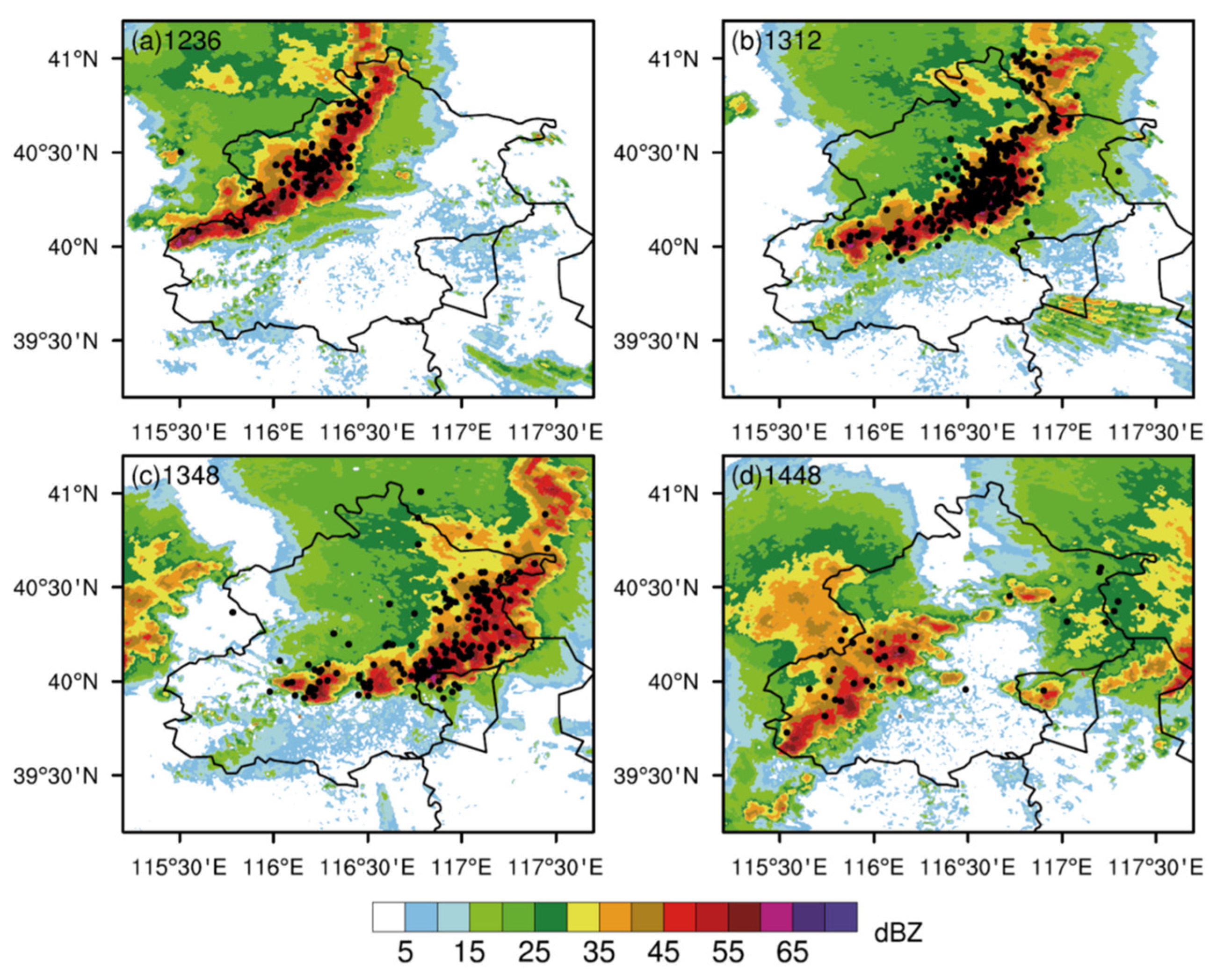
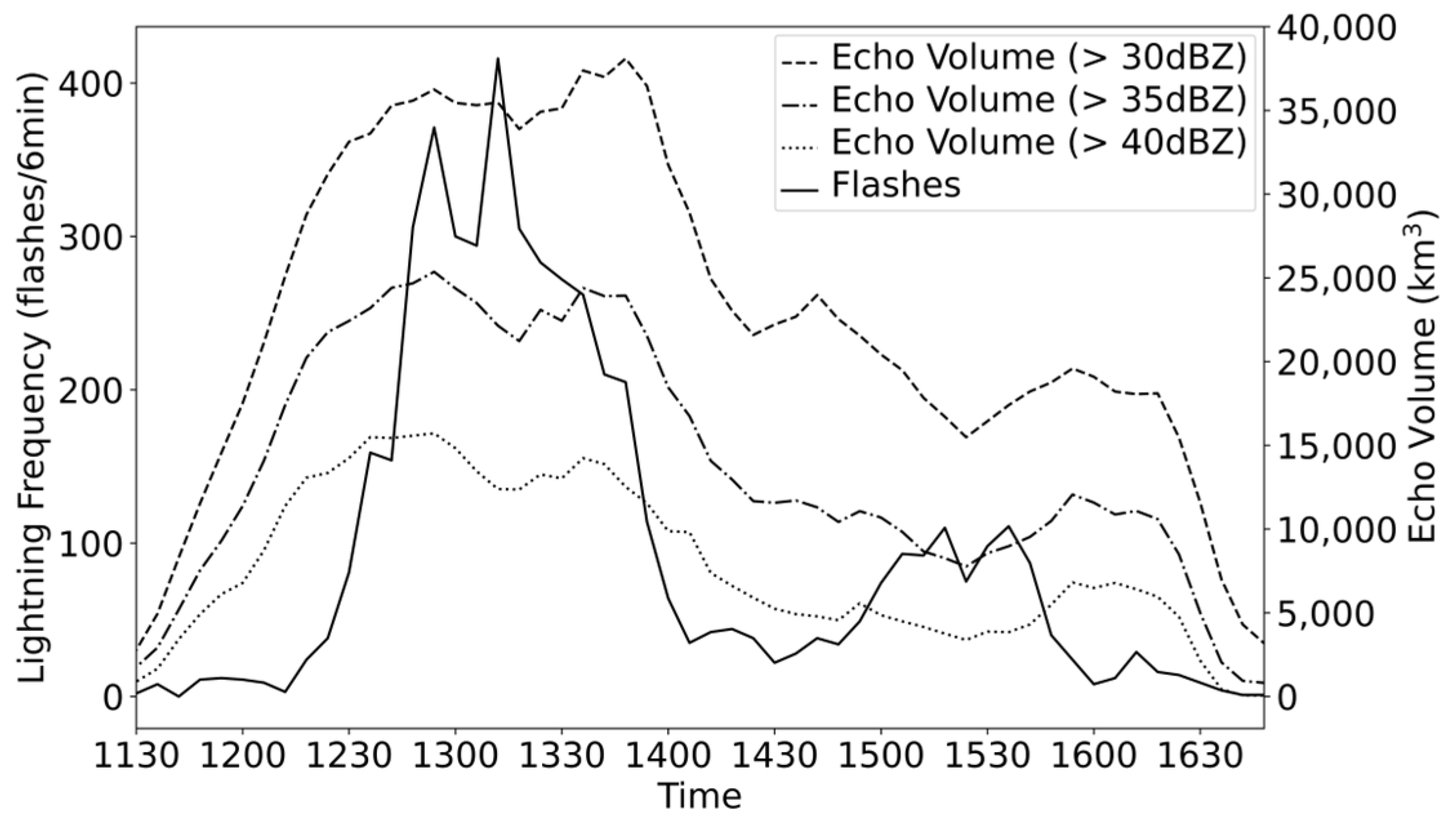


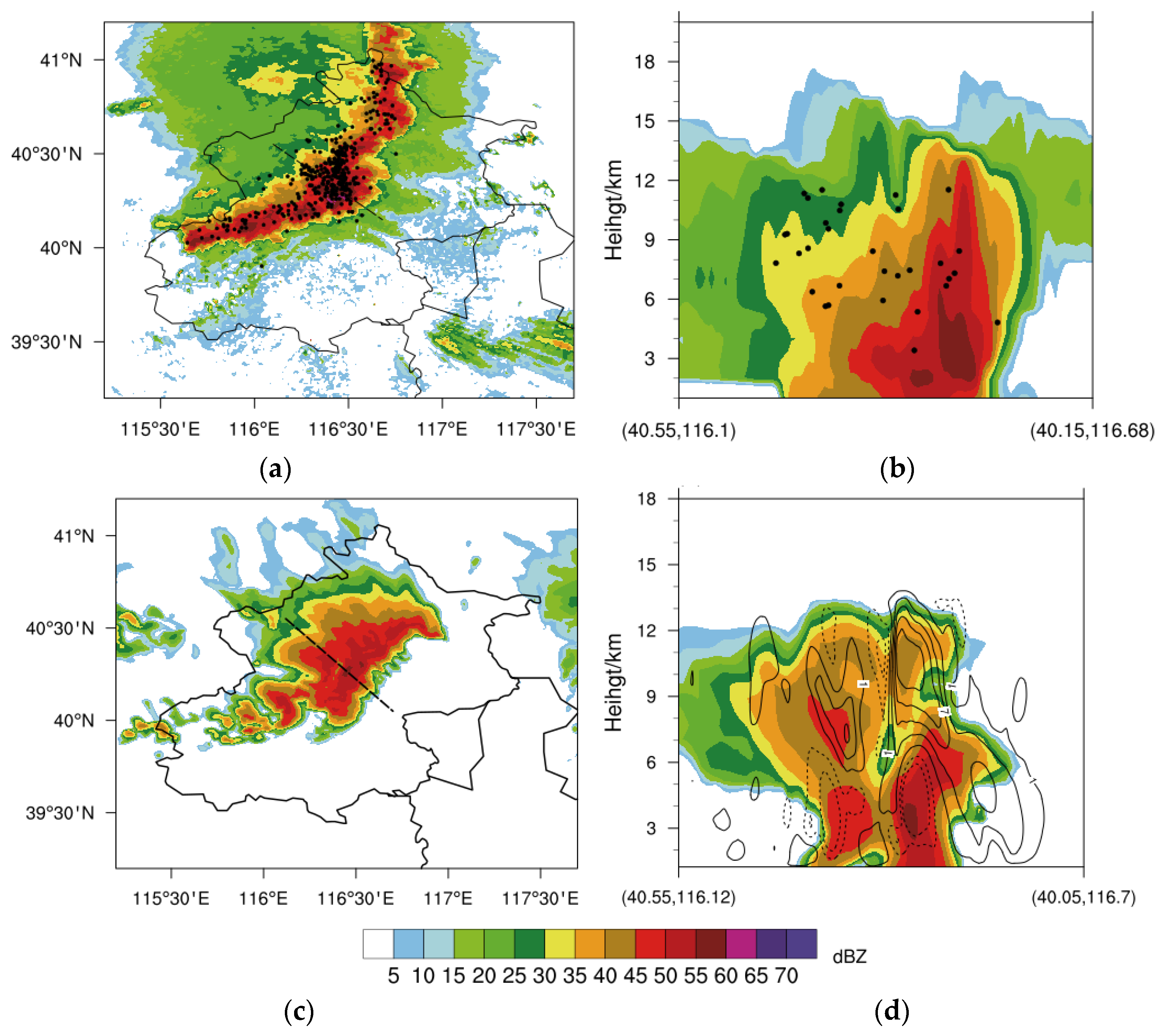
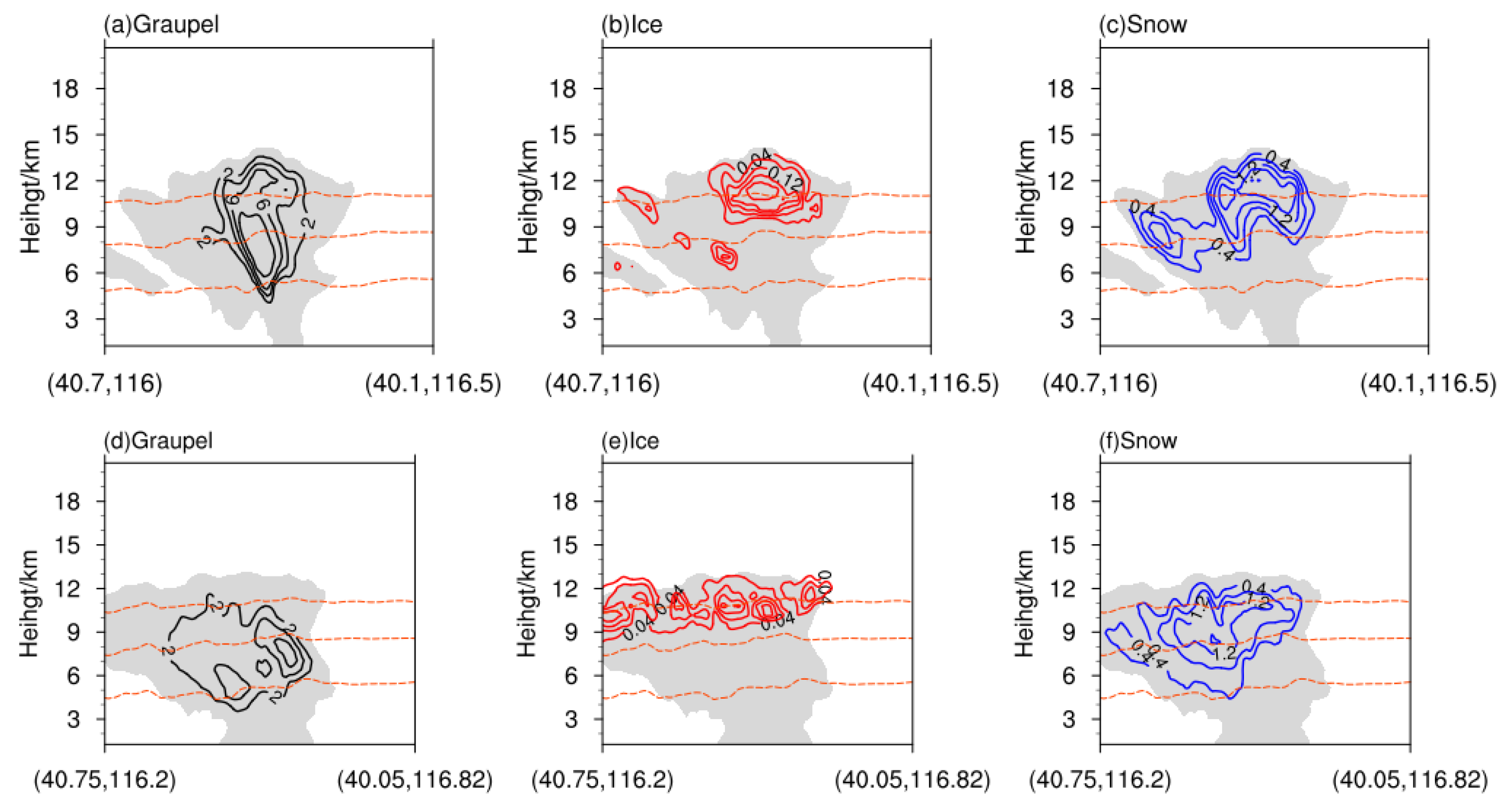
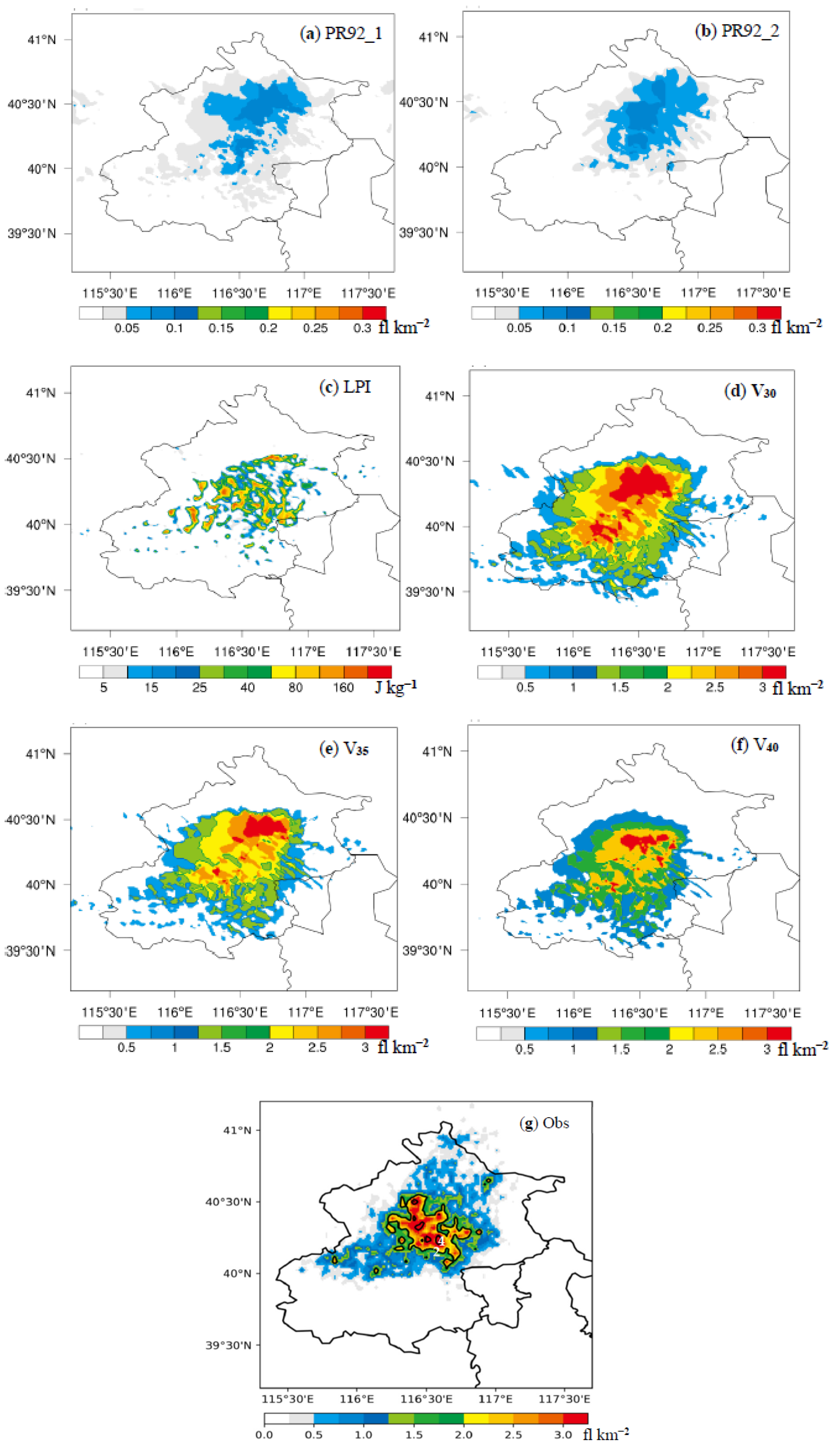
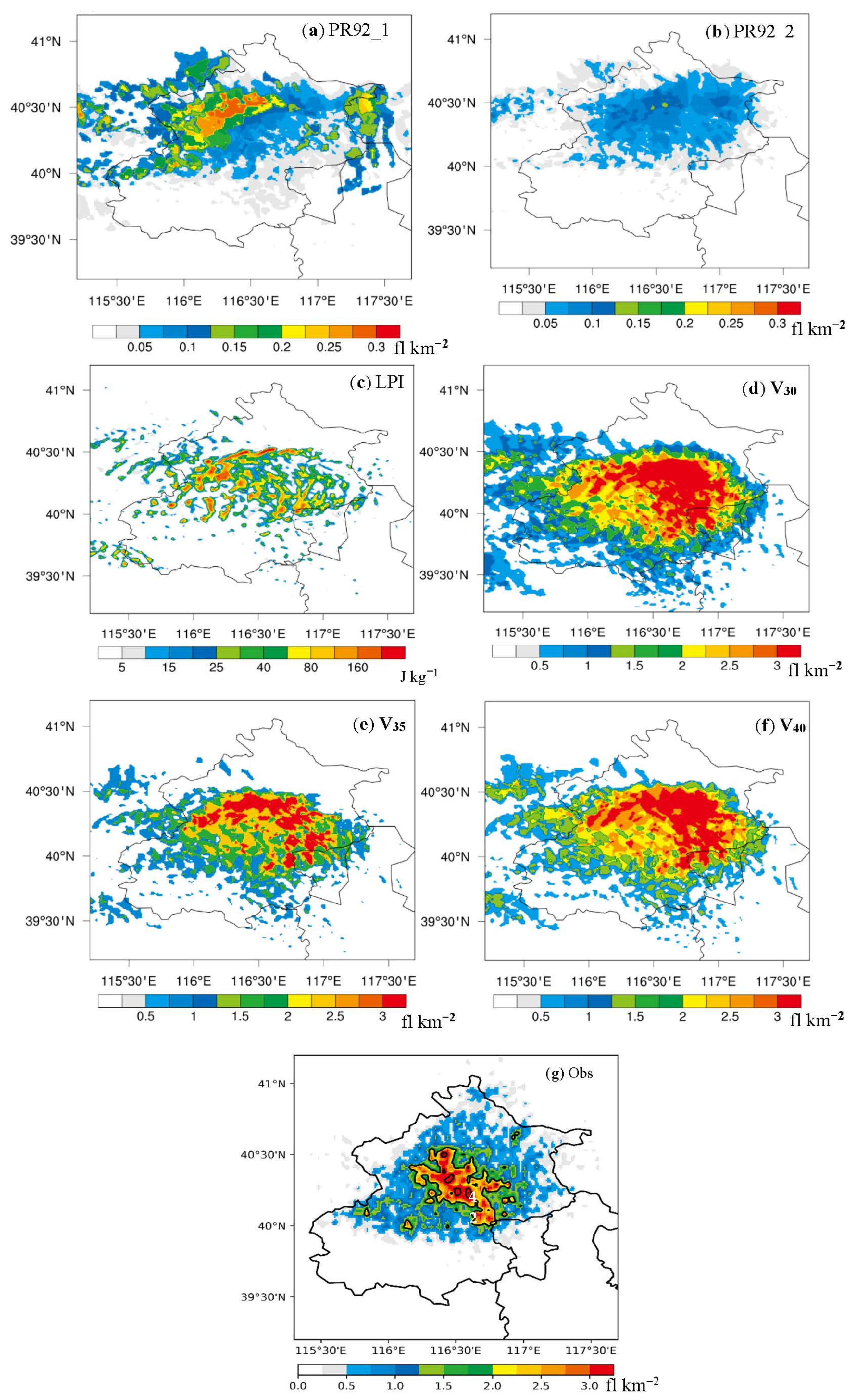
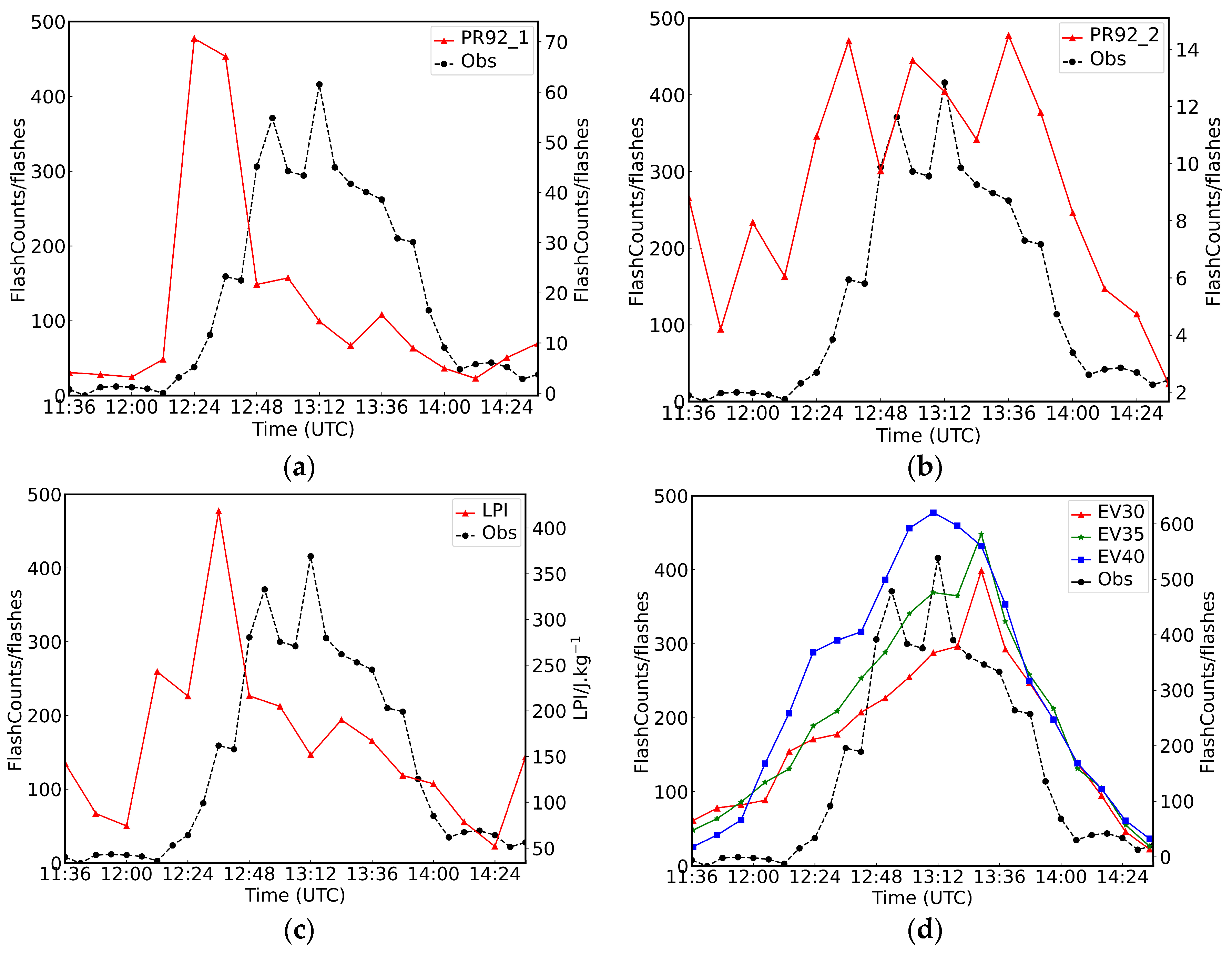
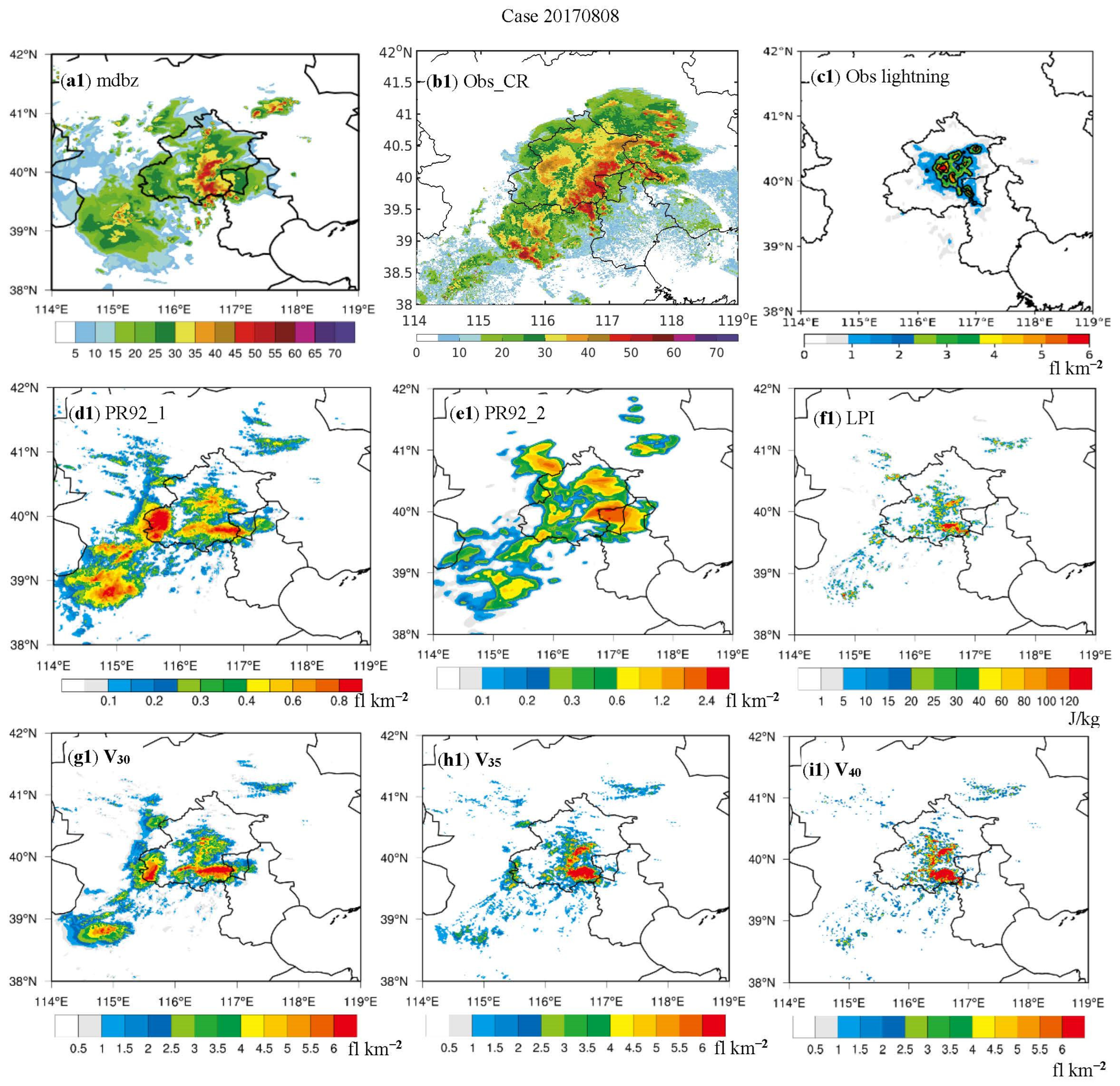

| Model Settings | Outer Domain 1 | Inner Domain 2 |
|---|---|---|
| Resolution | 3 km | 1 km |
| Area grid | 398 × 396 | 601 × 484 |
| Time step | 12 s | 12 s |
| Microphysics | WDM6 | WDM6 |
| Longwave radiation | RRTM | RRTM |
| Shortwave radiation | Dudhia | Dudhia |
| Boundary layer | BouLac | BouLac |
| Land surface | Noah Land Surface | Noah Land Surface |
| Cumulus parameterization | Kain–Fritsch | (Closed) |
| Cases | Time (UTC) | Average LF * (fl 6 min−1) | Maximum LF * (fl 6 min−1) | Synoptic Background (500 hPa) |
|---|---|---|---|---|
| 20150727 | 08:00~13:36 | 284.2 | 1256 | cold vortex |
| 20160609 | 07:00~23:12 | 35.3 | 118 | trough |
| 20160621 | 08:00~14:54 | 85.8 | 429 | trough |
| 20170707 | 11:30~16:48 | 95.2 | 416 | cold vortex |
| 20170713 | 10:00~19:36 | 115.1 | 617 | trough |
| 20170802 | 09:48~20:06 | 8.5 | 96 | trough |
| 20170808 | 09:42~19:54 | 51.2 | 328 | cold vortex |
| Fitting Model | R-Squared | a | b (10−4) |
|---|---|---|---|
| V30dBZ | 0.87 | 0.91 | 1.48 |
| V35dBZ | 0.83 | 1.51 | 2.03 |
| V40dBZ | 0.76 | 2.74 | 2.91 |
Disclaimer/Publisher’s Note: The statements, opinions and data contained in all publications are solely those of the individual author(s) and contributor(s) and not of MDPI and/or the editor(s). MDPI and/or the editor(s) disclaim responsibility for any injury to people or property resulting from any ideas, methods, instructions or products referred to in the content. |
© 2023 by the authors. Licensee MDPI, Basel, Switzerland. This article is an open access article distributed under the terms and conditions of the Creative Commons Attribution (CC BY) license (https://creativecommons.org/licenses/by/4.0/).
Share and Cite
Liu, D.; Yu, H.; Sun, C. Estimation of Lightning Activity of Squall Lines by Different Lightning Parameterization Schemes in the Weather Research and Forecasting Model. Remote Sens. 2023, 15, 5070. https://doi.org/10.3390/rs15205070
Liu D, Yu H, Sun C. Estimation of Lightning Activity of Squall Lines by Different Lightning Parameterization Schemes in the Weather Research and Forecasting Model. Remote Sensing. 2023; 15(20):5070. https://doi.org/10.3390/rs15205070
Chicago/Turabian StyleLiu, Dongxia, Han Yu, and Chunfa Sun. 2023. "Estimation of Lightning Activity of Squall Lines by Different Lightning Parameterization Schemes in the Weather Research and Forecasting Model" Remote Sensing 15, no. 20: 5070. https://doi.org/10.3390/rs15205070






